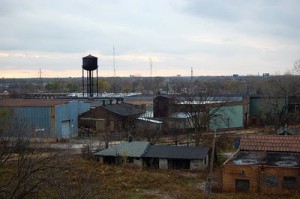By JACOB KANCLERZ
Capital News Service
LANSING — Despite attracting $14.4 billion in investments for developing contaminated properties the past 11 years, Michigan’s brownfield redevelopment program faces a $100 million cut.
The $150 million program coordinated by the Michigan Economic Development Corp. and the Michigan Department of Environmental Quality will be cut to $50 million this upcoming fiscal year.
The funding provides tax credits for developing brownfield sites — parcels of land contaminated above residential standards, said Daniel Wells, a brownfield program specialist with the Michigan Economic Development Corp.

Photo: EPA
Until now, brownfield funding was provided as a Michigan Business Tax credit. But the Legislature repealed that provision last spring, prompting the need for replacement funding.
The new Michigan Community Revitalization Program partially fills the void, doling out loans and grants rather than tax credits for brownfield redevelopment. The program has $50 million to split between brownfield projects, the historic preservation program and the Michigan Economic Growth Authority tax credit. Wells said it’s the first time that brownfield redevelopment hasn’t had its own funding.
The return on the state’s investment in brownfield redevelopment has been substantial, considering developers take up most of the costs, Wells said. The state has approved $1.1 billion in tax credits since 2000 compared to $14.4 billion pledged by developers.
Gov. Rick Snyder’s administration set out to level the business playing field by repealing most Michigan Business Tax credits. Critics said they were unfair because not every business was eligible for them.
But the brownfield cuts will lessen the availability of funds for local redevelopment efforts, said Carol Vining Moore, the chair of Marquette’s Brownfield Redevelopment Authority.
“I do feel it will be harder to find people who are interested in taking the risk of putting the additional dollars into developing sites without incentive money,” she said. “Because of the way the state is going to put the money that is available into a bigger pool, we’re all going to try to go after it.”
The brownfield program is intended for redeveloping Michigan communities that were once dominated by industry. Marquette has an extensive manufacturing past, with the coal industry and railroads dominating the Lake Superior shoreline, Vining Moore said.
One stretch, once known as the Bum’s Jungle, is developing into new condominiums and a hotel thanks to brownfield funds, she said. Even in the early phases of construction the project is attracting outsiders — and their money — to Marquette.
“The condos are selling to people from outside the area, as a result of that, we’re bringing new people into the area, which will benefit our economy,” she said.
In Cadillac, brownfield redevelopment funding has helped pay for downtown construction of a Chemical Bank and Dollar General, said Jerry Adams, the city’s director of community development.
“It’s been very important to us, particularly the redevelopment of sites in or near the downtown area,” he said.
Since 2000, the state has approved 1,005 brownfield projects for funding. They are intended to benefit downtown areas and to fight urban sprawl.
“We had this tremendous move out to the suburbs back in the ‘60s,” Wells said. “What we’re trying to do is bring the focus back on the cities, make them more livable, provide better services for people.”
With less money to distribute, fewer projects will be approved, Wells said. The state tracks the number of projects approved, but not the ones actually completed. He said the state will try to approve projects with better chances of success.
In the past, the agency wasn’t thorough in verifying developers’ finances before giving approval, Wells said. “Some of the projects we’ve approved for credits have not gone forward.”
In fact, Michigan’s auditor general reported in June 2011 that the Treasury Department did not collect financial status reports of brownfield redevelopment authorities and report them to the Legislature, which is required by law. As a result, there wasn’t enough information to evaluate the program’s effectiveness. The report stated the Treasury was working to correct the problem.
Treasury officials could not immediately be reached for comment.
New 2011 EPA mandates say that even a slow drain in your leach field or elevated Nitrate levels could require replacement of your entire system for $10,000 to $80,000 or connect to the city sewer.
2011 Septic, Well & Water News Stories:
Twitter MillerPlanteInc
Search News Stories by State:
Facebook miller.plante
The additional benefit of brownfield credits — besides cleaning contaminated property — is that it levels the playing field between cities and suburbs in competition for development. These credits are for commercial ventures (though they might be used for, say, a condo or apartment complex). If you’re a developer, why wouldn’t you look to greenspaces where it a) will not cost you upfront to clean the contaminated property and b) is less of a tax burden? In cities — without brownfield credits — it’s the exact opposite. Some economic developers largely attribute urban sprawl to the fact that it makes sense for developers’ bottom line to build on green spaces. Some cities, like Lansing, worry about this huge cut to the program because for the last 4, 5, 6 years, brownfield credits — along with other tax incentives — afforded a sort of momentum, where one development leads to another.
The tail end of this story, though, also reveals a truth about these incentive programs: That the state is not being responsible enough in tracking how these work out. Perhaps making the funds more competitive, as is pointed out in this story, will lead to the best projects succeeding. I’d say the governor asking for accountability is fair, but it remains to be seen if that’s his only motive with this policy decision … Maybe a flat $50 million is just an arbitrary number.
Well, I’m not surprised, after all the Repugs don’t believe that brownfields exist. In their eyes everything is green, especially the green bucks they get from corporate AmeriKa to deny, delay and disparage.